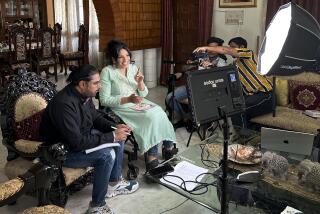Los Angeles Times
- Share via
Scrolling through TikTok, interspersed with cooking tutorials, outfit checks and dance challenges, storytimes are dominating For You Pages. They’re videos of creators sharing vulnerable experiences, or “lore,” as they like to call it.
Since early 2022, the app has allowed videos up to 10 minutes in length, but for some of the epic storytimes on the platform, 10 minutes is simply not enough time. Second, third and 10th parts of video series are now crowding the app more frequently. Just like TV cliffhangers, videos often end on a suspenseful note, building anticipation for the next installment.
Los Angeles Friends is a growing cohort of native Angelenos and recent transplants searching for deeper connections in Los Angeles.
Of course, there is no one path to virality. The app lends itself to short content, with the average video length for accounts with fewer than 50,000 followers clocking in at 35 seconds, according to the data gathering platform Statista. More popular accounts tend to produce content with an average length of 55 seconds. But there’s no doubt that long-form storytelling is on the rise.
Most recently, no one has done it bigger and better than Tareasa Johnson. Johnson, known online as Reesa Teesa, started posting her “Who TF Did I Marry?!?” series to TikTok in February, and the 52-part saga — which added up to six-plus hours — released over the course of three days, drew more than 400 million views in its first three weeks.
“No one can plan when something goes viral,” Johnson said. “But I truly did not think this would go viral, because it was so long. I kind of was like, ‘No one’s going to really sit there and watch all of this.’”

Still, day after day, people came back. They were captivated by Johnson’s hours-long narrative about how she “met, dated, married and divorced” a man she described as a “pathological liar.”
“I saw a lot of, ‘Hey girl, we’re waiting for the next part. Do you really have to go to sleep? Don’t sleep. Put up the next part. Like, we want more. We want more,’” she said.
A TikTok report in March found that viewership for longer videos had increased by 40% in the last six months. Users spent half their time on the app watching longer-form videos rather than the short content the platform was originally designed for.
Johnson’s detailed account of uncovering her now-ex-husband‘s alleged lies made her an overnight internet celebrity. She referred to him by the pseudonym Legion and never revealed his real name.
Storytimes have enthralled social media since their inception. In 2015, a 148-tweet thread from A’Ziah “Zola” King recounting a dangerous trip to Tampa, Fla., involving kidnapping and homicide, captured the zeitgeist. The saga was adapted into a 2020 feature film by A24.
Congress passed a bill that could ban TikTok. What could happen next, and who might buy the social media platform?
“Who TF Did I Marry?!?” isn’t getting the film or TV treatment yet — but Johnson is open to the idea.
The success of the series “opened the door for some really, really life-changing things,” she said, keeping her upcoming projects under wraps. Johnson was taking meetings in New York on the day of her interview with The Times in mid-August.
Just a few weeks after the series dropped, Johnson signed with CAA for representation. Along with landing TV appearances on “Good Morning America” and “Tamron Hall,” Johnson was a commencement speaker at the University at Buffalo and a keynote speaker at the inaugural Dear Future Husband retreat in Cancun, Mexico, hosted recently by the same-named podcast.
Johnson’s engaging storytelling drew in audiences, but she said it was her truthful and relatable account of being blindsided that made them stay for more.
“Initially, I felt like I was the dumbest person on Earth, and I felt like I was really alone. However, what I read was a lot of people have experienced this, whether firsthand or they know someone, and when I say this, I’m talking about the lies and the betrayal. That’s what I think resonated with people,” Johnson said. “I think the heart of it is we all kind of know someone — either ourselves or a friend or family member — who was done dirty.”

Johnson’s “Who TF Did I Marry?!?” inspired others to share their relationship nightmares in serialized fashion. In June, influencer Brooke Schofield dropped a 27-part TikTok series about ex-boyfriend Clinton Kane. Schofield did not expect the intense reaction, especially since she had already spoken about the short-lived relationship with the singer on her “Cancelled” podcast.
“If I had known how big [the videos] were going to be, I would have definitely maybe thought twice about it,” Schofield joked.
Her story went so viral that KamalaHQ — the official presidential campaign account of Vice President Kamala Harris — posted a video on TikTok last month featuring audio of Schofield’s comments from the series.
As Schofield was sharing her multipart saga, influencer Madeline Argy posted five videos alleging that an ex-boyfriend, rapper Central Cee, had cheated on her. Argy racked up millions of views and support online.
“I feel like we’re on FaceTime,” one user commented on Argy’s video.
Johnson said the conversational and intimate nature of her videos — some filmed while driving — contributed to their virality.
“To be honest with you, I just told the story in the most natural way that I talk. It’s nothing for me to hold the phone up, whether I’m on FaceTime with a friend or a family member, and just talk. ... What you see in that 50-part series is who I am,” Johnson said.
Hooked launched in 2015 with a mission to discover the next “Harry Potter” by testing stories with users. Now, it’s adapting them into short-form series.
June was prime time for storytelling on TikTok. Popular personalities, including Chris Olsen, Haley Kalil (known online as Haleyy Baylee) and Heather Bowling, all followed suit with multipart series. Kalil ultimately deleted the videos when users accused her of lying.
While Argy was likely inspired by Schofield’s recent virality — along with the release of Central Cee’s song with rumored girlfriend Ice Spice, “Did It First” — Schofield’s series was directly modeled after Johnson’s; the influencer even called it “Who TF Did I Marry?”
Schofield’s podcast co-host, Tana Mongeau, was the one who originally told her to do a “Reesa Teesa series.”
Johnson says she has seen almost all of the “Who TF” spin-offs from other creators.
“I think people feel like, ‘She went viral, and she went viral this way. So if I do that, I will also go viral,’ because I think that we live in a generation where people just automatically want to go viral and feel like viral equals money and equals fame,” Johnson said. “I love for people to share their story however they’re comfortable, but I do want to really encourage people to tell it in your own way and tell it however is authentic to you.”
Johnson told the Cut that she earned just $5,000 from the series because she applied late for the TikTok Creator Fund, which is used to monetize content based on video views and engagement.
A survey conducted for The Times by polling firm Leger in October found that Americans ages 18 to 34 spend as much time on TikTok as they do watching scripted television and movies combined. And 46% of 18- to 34 year-olds also said they watched more social media videos now than they did two years ago.
“People’s attention spans obviously are more geared toward short-form content now anyway, like mine certainly [is],” Schofield said. “I would watch a movie in 200 parts before I would watch a movie on the TV. It’s easier for me. So I feel like that might have contributed to why my story picked up now because it’s like it felt easier to consume probably in little parts than it did if I were to make a huge, sit-down, 40-minute YouTube video about it.”
In his new book ‘Filterworld,’ New Yorker writer Kyle Chayka argues that algorithmic curation dulls our creative agency.
In her “Who TF Did I Marry?” series, Schofield alleges that Kane fabricated his mother’s and brother’s deaths and lied about being Australian. She also says he cheated on her and isolated her from her friends.
Two and a half weeks later, Kane responded with his own 26-part saga called “Who Did I Date Not Marry?” Although his videos weren’t as well-received as Schofield’s — at the time, TikTok users rallied around her — he still garnered at least 1.5 million views per video.
That same day, Schofield denied Kane’s claims that she was exaggerating the story in another 12-part follow-up series.
The pair had contradicting stories. While TikTok is a powerful tool for self-expression, users rarely have a way to fact-check the validity of stories.
“The public rehashing of these details is only an attempt to bring attention and focus on Brooke’s podcast, at the expense of tearing down another former boyfriend — a tactic she’s become known for,” a representative for Kane told People in June.
Johnson knew her story would be picked apart, so she tried to provide as much detail as possible. That did not stop internet sleuths — and Legion himself, who’s denied all allegations — from trying to discredit her.
“Sometimes you will tell your story, and you’re going to have to be prepared to stand on your story, even if you got to stand alone,” Johnson said. “I know every single thing in that story happened.”
In a sharp turn of events, Schofield recently came under fire for racist tweets she wrote from 2012 to 2016 mocking minorities and defending George Zimmerman’s killing of Trayvon Martin. Schofield posted three apology videos on TikTok after the tweets resurfaced.
“Sorry is not enough, in my opinion, for the way that I was tweeting and the things that I was saying online at that time. And I know that there is no apology beyond like reparations that can mend that wound,” Schofield said in an Aug. 8 post. “I don’t care if I was a teenager. I was old enough to know better.”
Schofield did not appear in the most recent episode of “Cancelled,” and it is unclear whether she will return as co-host. A representative for the podcast did not respond to The Times’ request for comment.
More to Read
The biggest entertainment stories
Get our big stories about Hollywood, film, television, music, arts, culture and more right in your inbox as soon as they publish.
You may occasionally receive promotional content from the Los Angeles Times.















